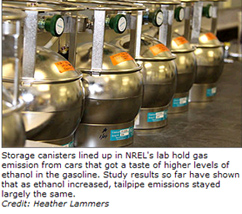 The National Renewable Energy Laboaratory (NREL), a laboratory for the Department of Energy, is testing higher blends of ethenol to be used in vehicles. Researchers are trying to find out, because these new ethanol blends could play a significant role as America tries to wean itself off petroleum based fuels.
The National Renewable Energy Laboaratory (NREL), a laboratory for the Department of Energy, is testing higher blends of ethenol to be used in vehicles. Researchers are trying to find out, because these new ethanol blends could play a significant role as America tries to wean itself off petroleum based fuels.
The Energy Independence and Security Act of 2007 (PDF 821 KB) (EISA) is one force behind the quest for higher ethanol blends. The 2007 law requires that the U.S. use 36 billion gallons of renewable fuels by 2022. But, a leaner benchmark is just around the corner, with 15 billion gallons required by 2012.
“We’re pushed right now to find ways to get more ethanol into the fuel stream,” said Keith Knoll, senior project leader for NREL’s Fuels Performance Group.
Currently, ethanol is the most widely used and readily available renewable fuel. As a result, it is a likely candidate to make up a significant chunk of the 36 billion gallons required under EISA. Ethanol as a motor fuel is commonly found in E85, a fuel intended for use only in Flexible Fuel Vehicles (FFVs). Ethanol also is widely used as a 10 percent blend in standard gasoline (E10) to reduce carbon monoxide emissions and smog. But, increasing ethanol from the current 10 percent blend to a proposed blend of E15 or even E20, brings up a whole host of questions and issues.
For instance, E20 is currently not allowed for use in conventional automobiles under the Environmental Protection Agency’s (EPA) Clean Air Act. This is where research from NREL and Oak Ridge National Laboratory (ORNL) will play a pivotal role in understanding how blends like E15 and E20 affect vehicles currently in the market. The research is examining whether using higher ethanol blends will have an adverse impact on tailpipe emissions, exhaust temperatures, catalytic converters and engine performance and durability.

